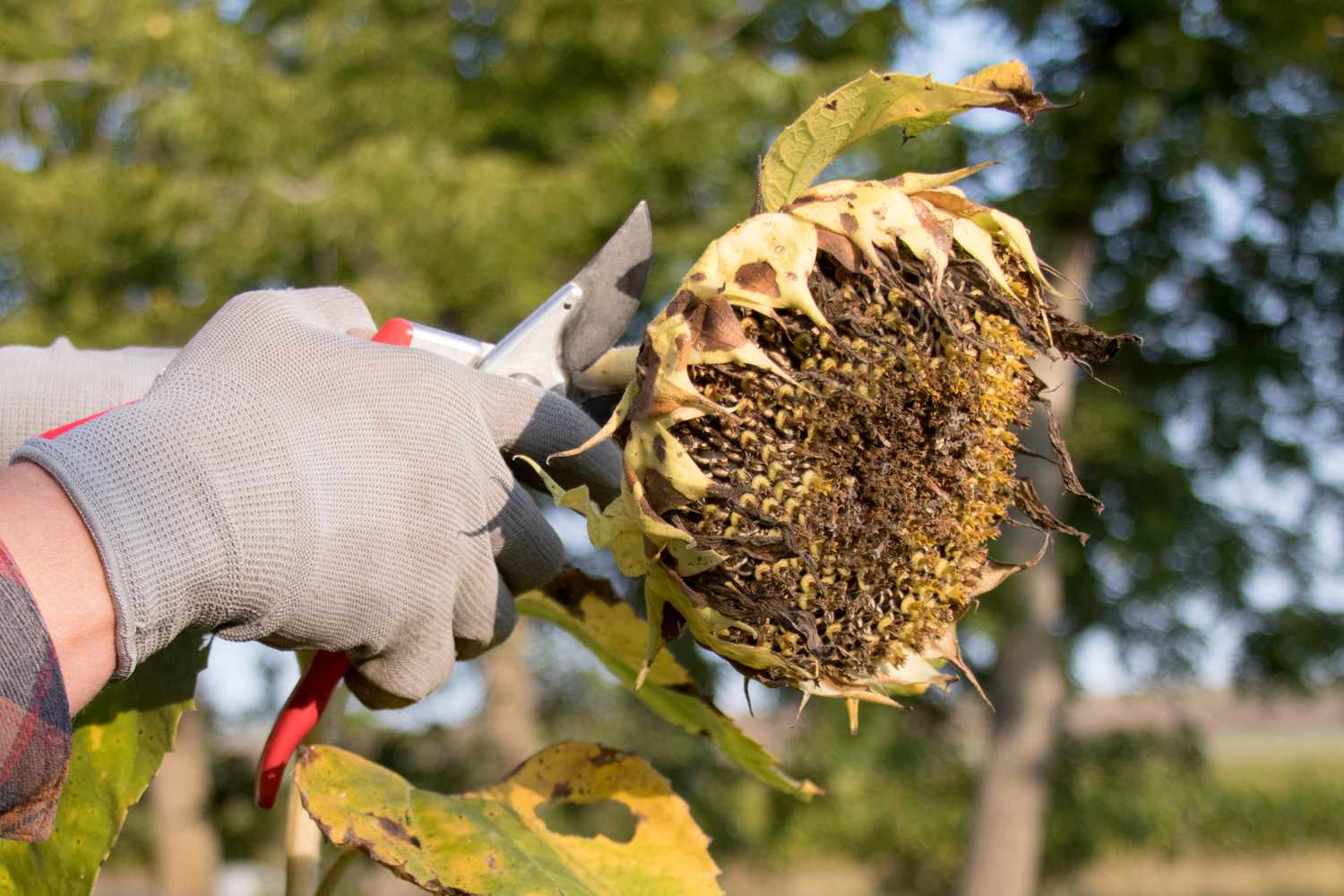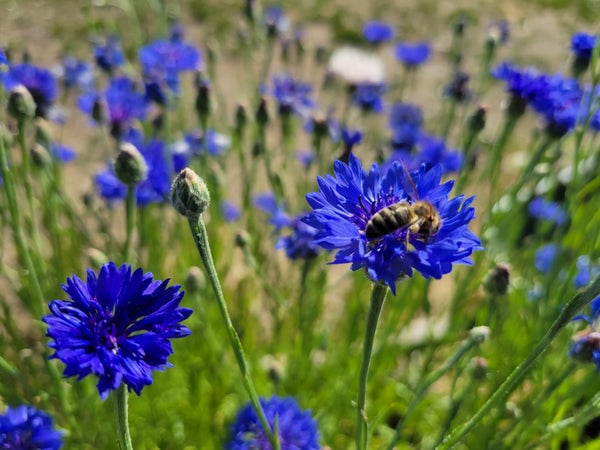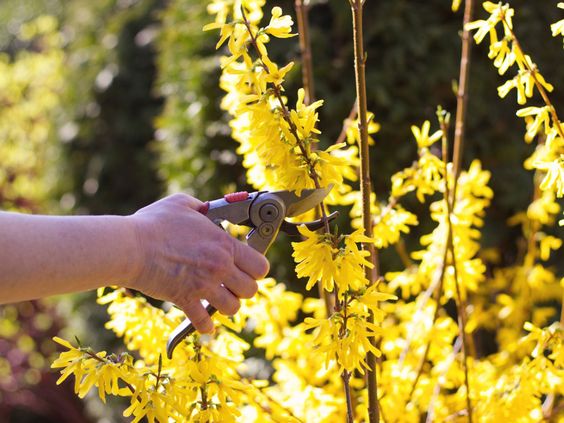Increase Sunflower Yield: Learn How, when And Why to Deadhead

Table of Contents
Are you someone who loves sunflowers or enjoys having a garden full of beautiful flowers? If yes, then you might be curious about the practice of deadheading sunflowers. It’s a simple yet essential process that can significantly impact the health and appearance of your sunflowers.
You can encourage fresh blooms, avoid Disease, and improve the overall aesthetic of your garden by eliminating faded flowers. In this article, we’ll discuss the reasons behind deadheading. It will also help you to know when and how to deadhead sunflowers.
So, let’s get started and keep your sunflowers looking their best throughout the season!
Why Should You Deadhead Sunflowers?

Deadheading sunflowers are crucial for promoting continuous blooming, preventing Disease spread, and enhancing the plant’s appearance. It redirects the plant’s energy towards new blooms and prevents fungal and bacterial diseases from spreading. In addition, removing wilted or dead flowers improves the plant’s aesthetics, producing healthy and vibrant sunflowers. Deadheading is an easy and essential practice for ensuring well being and attractiveness of sunflowers.
Below are the reasons you should know for deadheading sunflowers
1. Encourages Continued Blooming
One of the main reasons for deadhead sunflowers is to encourage continued blooming. Like many other plants, sunflowers naturally produce seeds as their flowers fade. However, removing the faded blooms prevents the plant from focusing its energy on seed production, allowing it to direct that energy toward creating new flowers instead. As a result, deadheading can lead to more abundant and longer-lasting blooms. It’s crucial if you’re growing sunflowers for their ornamental value and want to enjoy their bright and cheery appearance throughout the growing season.
2. Prevents Disease
Another reason is to prevent Disease. Faded flowers can become breeding grounds for fungal and bacterial infection, which can then spread to the rest of the plant and potentially cause significant damage. Removing the spent flowers can help reduce the disease risk and ensure your sunflowers remain healthy.
3. Enhances Aesthetics
Deadheading sunflowers can significantly enhance the overall appearance of your garden. Faded or wilted flowers can make a plant look untidy and unattractive, while fresh, vibrant blooms can add unique colour and vibrancy to your garden. By deadheading regularly, you can maintain your sunflowers’ neat, tidy appearance and ensure they look their best throughout the season. It’s a simple way to improve the aesthetic of your garden and make it a more enjoyable place to spend time.
When Should You Deadhead Sunflowers?
Deadheading is a common gardening practice involving removing old plant flowers. Deadheading sunflowers can help promote more blooms and keep the plant neat. However, knowing when and how to deadhead sunflowers can be tricky, as different sunflowers have different blooming patterns and life cycles.
The first thing to understand is that sunflowers are annuals, meaning they complete their entire life cycle within a single growing season. Most sunflowers bloom in the summer, with their peak flowering period typically occurring in mid to late summer. Once a sunflower has blossomed, the spent flower head will begin to produce seeds, which will eventually mature and fall off the plant.
Deadheading sunflowers is good practice once most of their blooms have faded and begun to form seeds. When a sunflower enters the seed-producing phase, it channels its energy away from creating fresh colours and toward seed production. You may help the plant shift its energy away from producing seeds and towards building new blooms by deadheading the dying flowers.
- One of the well-known ways to tell if it is time to deadhead your sunflowers is to look at the flower heads.
- Once the petals have fallen off and the centre of the flower has turned brown and begun to dry out, the head is ready to be deadheaded.
- To do this, cut the stem below the spent flower head, leaving a few inches of stem intact.
- This will help to prevent the stem from rotting and potentially causing damage to the plant.

It is crucial to note that not all sunflowers need to be deadheaded. Some sunflower varieties, such as those explicitly grown for their seeds, should be left to produce seeds. These types of sunflowers typically have smaller, less showy blooms. Their primary purpose is to plant seeds for human consumption or bird food.
In addition to promoting more blooms, deadheading sunflowers can help prevent self-seeding. Suppose you allow the spent flowers to remain on the plant. In that case, they will eventually produce seeds that will drop to the ground and potentially sprout new sunflowers. While this can be a desirable trait for some gardeners, others may prefer to control where their sunflowers grow.
Sunflower plants can seem more appealing to the eye while promoting new blooms by removing the old flowers. More than half of a sunflower’s colours should have faded and started to develop seeds before deadheading. Knowing what variety of sunflowers you are planting and how to deadhead sunflowers is vital since some types should be allowed to set roots. Your sunflowers’ energy can be directed towards generating new blooms and away from self-seeding by deadheading, which also helps to prevent them from doing so.
How to Deadhead Sunflowers?
Deadheading is a trouble-free process, but knowing how to deadhead sunflowers is vital. Although, it can be taken care of by just following a few easy steps. Removing the faded flower heads can boost the plant for more blooms and keep your sunflowers healthy and attractive.
When deadheading sunflowers, the right cutting tool is crucial to ensure a clean cut without damaging the plant. A scissor or a pair of hand pruners should do the deadheading sunflowers well.
- Pruning Shears fit for cutting stems and light branches up to 3/4″ diameter size
- Quality sharp blade made of high carbon alloy steel with antirust processing
- Safety Lock – easy open/close lock for convenient security system
1. Disinfect Cutting Tools
To maintain the well-being and vitality of your sunflowers, it’s important to disinfect your cutting tools before proceeding. Cutting tools that have not been sanitized can transfer diseases from one plant to another, potentially causing irreversible damage to your garden. By taking a few minutes to disinfect your tools properly, you can help prevent the spread of infectious diseases and ensure the continued growth and health of your sunflowers.
For disinfecting the equipment, you can use any household cleaner or isopropyl alcohol solution to prevent the plant from causing damage or infection. By following these simple steps to disinfect your cutting tools, you can ensure that you work with a clean and safe tool that won’t harm your sunflowers. Wear gloves, protective eyewear, and long sleeves during deadheading sunflowers to avoid cuts from thorny stems.

If you want to unlock the maximum potential of your sunflower garden, there are certain things you can do. In a Sunflower garden, deadheading is a crucial task. However, timing is everything. So, when and how to deadhead your sunflower? Well, the best time is when most blooms have reached the end of their life and started producing seeds. But how do you know if your sunflower is ready for deadheading? The answer is simple – take a look at the flower head! Once the vibrant petals have fallen off and the centre of the flower has turned brown and started drying out, you can pluck the flower head off easily and redirect the plant’s energy toward fresh, new blooms.
2. Select the Dead Flower
Begin by selecting the flower head that you want to remove. Next, make sure the stem below the flower head is still green and healthy. It would be best to look at the stem of a wilted bloom and then follow it down to find the point of origin of a fresh side flower or branch.
3. Perform Incision

Hold the stem firmly and slice it at a slight angle just below the flower, leaving about half an inch of stem above the first set of leaves or new lateral flower or branch. Then, using your sharp-edged pruning shears, cut the stem below the flower head, leaving a few inches of stem intact. Deadheading sunflowers boost the growth of new blooms and prevent stem rot that could cause severe harm to the plant. Ensure that the remaining stem is angled to point upward toward the sky.
4. Discard the Debris
After you have removed the spent flower head, you can discard it or use it for decorative purposes. For example, some gardeners like to use sunflower heads in floral arrangements or as bird feeders by filling the centre with seeds and hanging it up in a tree.

Not all sunflowers need to undergo the process of deadheading. Certain sunflower species, particularly those cultivated for their nutritious seeds, should be left untouched to fulfil their seed-bearing purpose. These varieties may have smaller blooms that are less showy. Still, they serve a vital role in producing seeds that humans can consume or enjoy as a portion of nourishing bird food.
Those who adore sunflowers should be aware of how to Deadhead sunflowers. By snipping off the spent flowers, you’re encouraging more blooms to form and avoiding the self-seeding of sunflowers. However, if left unattended, the spent flowers will naturally produce seeds that can quickly drop to the ground and potentially sprout new sunflowers in unpredictable locations. While some gardeners may relish this surprise element, others may prefer to have more control over the placement of their sunflowers.
In addition to deadheading, you can take a few additional steps to keep your sunflowers looking lovely and healthy. One crucial step is to provide them with regular water and fertilization. Sunflowers are heavy feeders and require plenty of nutrients to produce their large blooms. Therefore, you can use a balanced fertilizer to give your sunflowers the nutrients they need to thrive.
Another critical step is to support your sunflowers. Sunflowers can grow tall and heavy, and their stems can quickly become damaged or broken in windy conditions. Providing them with essential support in the form of stakes or cages can help to keep them upright and prevent damage.
So, by incorporating this simple practice into your gardening routine, you can enjoy a stunning and thriving sunflower display throughout the growing season.
You can effortlessly enhance your sunflower’s blooming potential with the patience of well-maintained pruning shears. You can redirect your plant’s resources toward developing fresh, vibrant flowers by carefully snipping them off until most blooms have lost their lustre. This simple technique allows you to optimize your sunflower’s energy, encouraging it to produce new and captivating colours that will elevate the beauty of your garden.
Conclusion
We hope this discussion provided insight into when and how to deadhead sunflowers for optimal blooming. Sunflowers are a delightful addition to any garden or landscape, but maintaining their beauty and health requires some effort. However, deadheading sunflowers is an easy and effective technique that can help to keep them looking their best.
Deadheading sunflowers can stimulate the growth of new flowers and prevent the plant from self-seeding – remove the spent flower heads to keep your garden looking its best. You only need a pair of sharp pruning shears or scissors and some patience to wait until the blooms are ready. With proper care and attention, your sunflowers can thrive and provide a stunning display for many seasons. So why wait? Give your sunflowers the respect they deserve by deadheading them today, and watch as they continue to thrive and bring joy to your garden.







